The AMD Ryzen 9 7950X3D Review: AMD's Fastest Gaming Processor
by Gavin Bonshor on February 27, 2023 9:00 AM ESTCPU Benchmark Performance: Power And Office
Our previous sets of ‘office’ benchmarks have often been a mix of science and synthetics, so this time we wanted to keep our office section purely on real-world performance. We've also incorporated our power testing into this section too.
The biggest update to our Office-focused tests for 2023 and beyond include UL's Procyon software, which is the successor to PCMark. Procyon benchmarks office performance using Microsoft Office applications, as well as Adobe's Photoshop/Lightroom photo editing software, and Adobe Premier Pro's video editing capabilities. Due to issues with UL Procyon and the video editing test, we haven't been able to properly run these, but once we identify a fix with UL, we will re-test each chip.
We are using DDR5 memory on the Ryzen 9 7950X3D and the other Ryzen 7000 series we've tested. This also includes Intel's 13th and 12th Gen processors. We tested the aforementioned platforms with the following settings:
- DDR5-5600B CL46 - Intel 13th Gen
- DDR5-5200 CL44 - Ryzen 7000
- DDR5-4800 (B) CL40 - Intel 12th Gen
All other CPUs such as Ryzen 5000 and 3000 were tested at the relevant JEDEC settings as per the processor's individual memory support with DDR4.
Power
The nature of reporting processor power consumption has become, in part, a bit of a nightmare. Historically the peak power consumption of a processor, as purchased, is given by its Thermal Design Power (TDP, or PL1). For many markets, such as embedded processors, that value of TDP still signifies the peak power consumption. For the processors we test at AnandTech, either desktop, notebook, or enterprise, this is not always the case.
Modern high-performance processors implement a feature called Turbo. This allows, usually for a limited time, a processor to go beyond its rated frequency. Exactly how far the processor goes depends on a few factors, such as the Turbo Power Limit (PL2), whether the peak frequency is hard coded, the thermals, and the power delivery. Turbo can sometimes be very aggressive, allowing power values 2.5x above the rated TDP.
AMD and Intel have different definitions for TDP that are, broadly speaking, applied the same. The difference comes from turbo modes, turbo limits, turbo budgets, and how the processors manage that power balance. These topics are 10000-12000 word articles in their own right, and we’ve got a few articles worth reading on the topic.
- Why Intel Processors Draw More Power Than Expected: TDP and Turbo Explained
- Talking TDP, Turbo and Overclocking: An Interview with Intel Fellow Guy Therien
- Reaching for Turbo: Aligning Perception with AMD’s Frequency Metrics
- Intel’s TDP Shenanigans Hurts Everyone
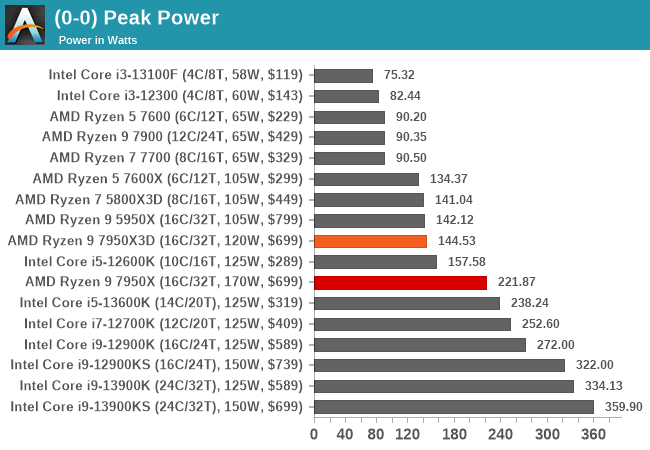
Given that the Ryzen 9 7950X3D has a lower TDP and PPT rating than the Ryzen 9 7950X, it pulls less power. We observed a peak power output of 144.53 W on the 7950X3D, compared to 221.87 W on the 7950X. Talking figures, the Ryzen 7950X3D is pulling around 65% of the power of the 7950X, which is understandable given the power limitations due to the CCX laden with AMD's 3D V-Cache packaging.
Looking at the power consumption of the Ryzen 9 7950X3D in closer detail, we can see that it delivered a consistent load of between 140 and 144 W in our Prime95 sustained power test. This is around 18 Watts lower than the official Package Power Tracking (PPT) level AMD has set at 162 W. However, it operates higher than the TDP of 120 W, which is to be expected. The TDP and PPT ratings are different as the TDP is the base power the CPU should be drawing, while the PPT (socket), set at 162 W, is the maximum the processor can draw as a maximum under full load.
Office/Web
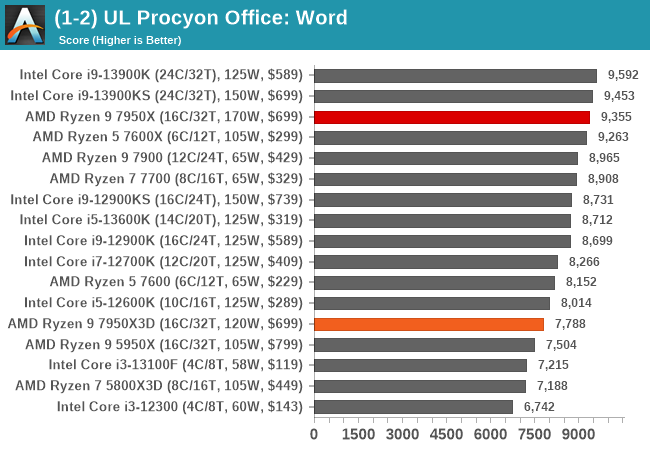
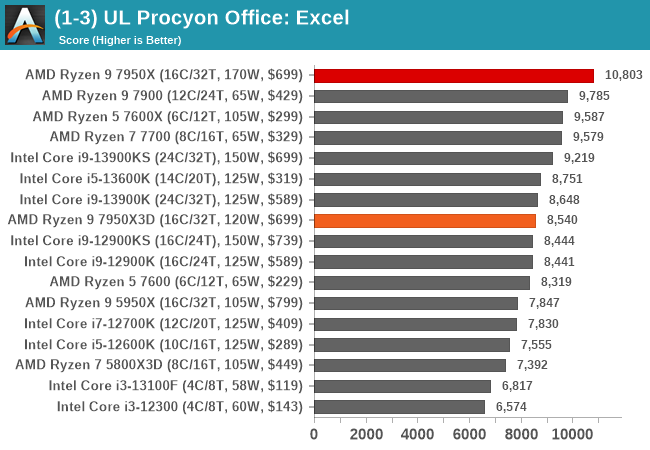
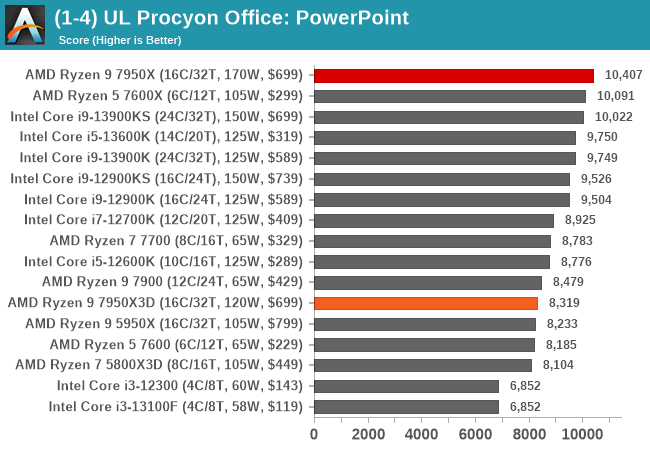
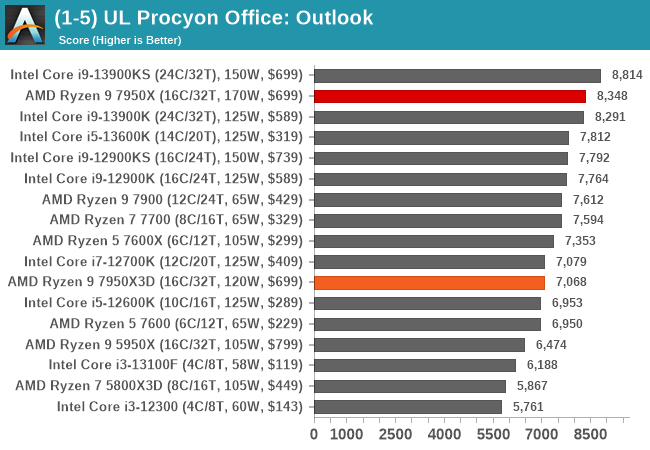
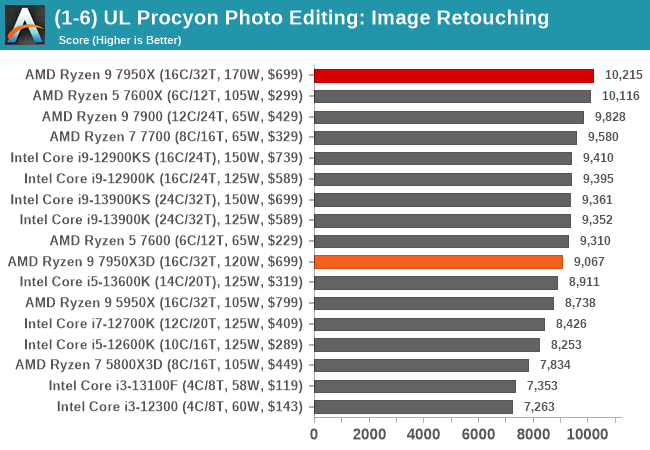
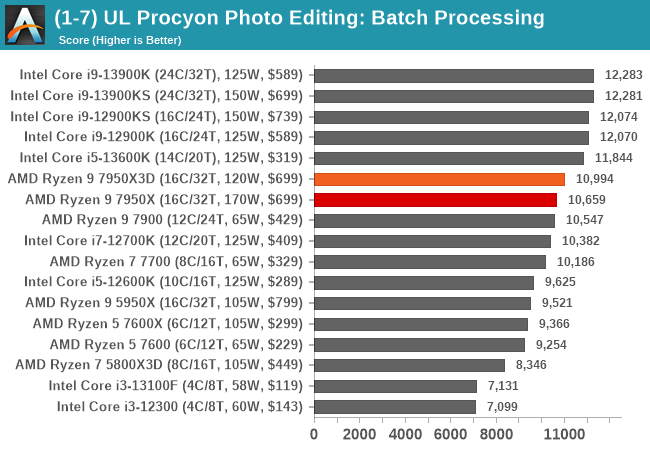
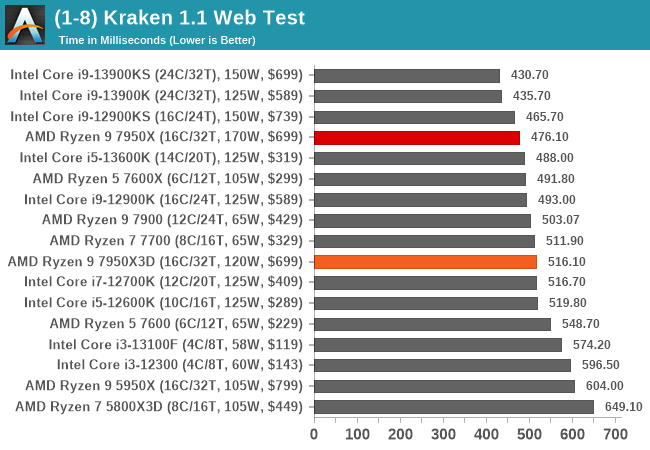
In our office-based testing, the Ryzen 9 7950X3D performs a little worse than the 7950X, but this is to be expected given the differences in TDP, PPT, and the overall power envelope. Still, the 7950X3D performs well and is more than suitable for office and web-based tasks.


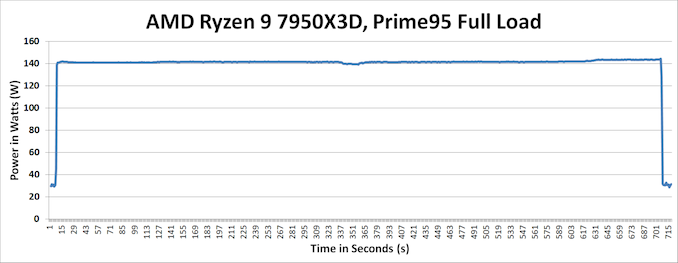








122 Comments
View All Comments
cruiseliu - Monday, February 27, 2023 - link
Thanks, looking forward to see updates.Otritus - Monday, February 27, 2023 - link
AMD does not have an intelligent scheduler built into their CPUs to handle the heterogeneous design like Intel. As a result that have a driver that is basically just: if a game is detected then only schedule on the V-Cache CCD. This driver is imperfect as is for games as seen with Factorio, and clearly not optimized for other workloads. The Windows 11 scheduler will typically park threads on the higher frequency CCD because the driver is supposed to tell it not to. As a result, the driver isn’t activating causing threads to be scheduled on the higher frequency CCD and performance is worse than the 7950X because the X3D has a lower power limit and all-core turbo.cruiseliu - Monday, February 27, 2023 - link
Yeah I know the scheduler is basically "if game then cache else frequency".But Dwarf Fortress and Factorio are also games, though not 3D games. So it seems hard to say which CCD will be used.
Gavin Bonshor - Monday, February 27, 2023 - link
Yeah, that's right about the 'scheduler.' It hinges on Xbox Game Bar feeding the information to the drivers if A. If it's a game, park one CCD and enable V-Cache CCD or B. Not a game, then act as normal.In relation to Factorio, I know our version in our suite is without the UI, which is possibly why it wasn't flagged. As this is more of a CPU benchmark in our suite than a game, it is reflected in the method of data.
That's why I did a side test with Factorio on the CCD with V-Cache, which, as expected, boosted performance by nearly double.
I'm in the process of doing additional testing, so bare with me
Bruzzone - Monday, February 27, 2023 - link
7X 3D 1P + 1P offload engine seems underwhelming on initial assessment. mbnightbird321 - Monday, February 27, 2023 - link
Wow AnandTech, pulled out the slowest DDR5 money can buy for this review and didn't pair the Ryzen 7000 with "sweetspot" 6000 speed ram, and put 5 pages of productivity to 4 pages of gaming benchmarks for a "Gaming" CPU. Just WOW. The other site known for biased Intel reviews did a flip flop as well, what is the world coming to.Gavin Bonshor - Monday, February 27, 2023 - link
We test at JEDEC settings; that's just how we do it. Check ANY of our CPU review content going back multiple years.eloyard - Friday, March 3, 2023 - link
Isn't the point of testing missed if the testing is done in wildly suboptimal fashion that does not reflect real world configuration? On one hand you have overpowered cooling, PSU, MB and GPU, but on the other the real bottleneck for some core designs: RAM - is artificially kept slow? Either you run top of the line enthusiast spec or some basic discount shop bad config. The excuse "we've always been doing that" feels hollow. If you've been doing it wrong, you should correct that, not try to make that point of virtue. You've might as well tested all with 300W PSU and basic air cooler and claim the same, and in same vane such "CPU testing" wouldn't show what people are expected to see - how CPU will behave in a real life config.cruiseliu - Monday, February 27, 2023 - link
Theoretically EXPO and XMP are overclocking.Though most of us treat them as standards nowadays...
Ryan Smith - Monday, February 27, 2023 - link
More specifically, they will invalidate your CPU warranty. That is our single largest issue with XMP/EXPO right now.